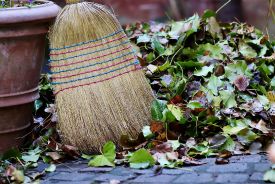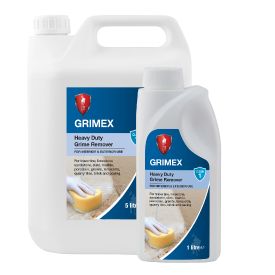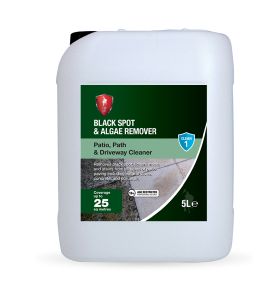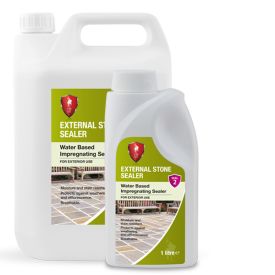
In years gone by, patio areas were “put in bed” in early autumn. Nowadays, with the advent of products like outdoor heaters, hot tubs and lounge-style furnishings, these spaces are used year-round. This makes regular maintenance even more important, to ensure that spaces are safe and well-kept during the damper, colder months.
Establishing an outdoor regime
Path and patios will benefit from a thorough clean every couple of months or so – ideally, twice during the winter and three times during late spring/summer. Surfaces that are regularly cleaned will be far easier to keep clean. Regular cleaning of inside-to-outside surfaces, like those that run through bifold doors, will also help maintain a seamless aesthetic.
Before embarking on a late summer clean-up, identify any furnishings or materials that aren’t winter or frost proof; these will need to be packed away or covered up before the weather turns. It’s worth emptying and stacking pots as soon as flowers are spent to make patio maintenance easier; some might need to be stored away if they’re not frost-resistant. Pavers can then be swept to remove dirt, debris and fallen leaves.

It’s worth sweeping up leaves on a regular basis, as they can quickly decay and cause a slip hazard. Certain leaves, like sycamores, are a particular menace; aphids that live on the surface of the leaves excrete a sugary substance that provides a food source for algae. The combined sugar and bacteria leaves a telltale black spot stain and sometimes whole leaf prints.
A note about pressure washing:
A blast with a jet wash may seem like a quick and easy way to clean pavers but it will only wash dirt off the surface. Over the autumn and winter, use of excessive amounts of water can exacerbate staining and slip issues. Jet washing can also loosen grout, erode a stone surface and damage any protective sealant applied. A specialist treatment will react with ingrained residue and organic matter, drawing it out of the stone’s porosity, and will also help to prevent regrowth of algae and other organic material.
Cleaning pavers – recommended products & methods
To properly remove stains and ingrained dirt, we recommend a thorough wash with LTP Grimex. This treatment is also especially effective at removing leaf stains, including those left by Sycamore leaves. Before cleaning, remove furniture, pots and other objects. Then, test your cleaning solution on an inconspicuous area.

How to apply LTP Grimex:
- To remove mild staining, dilute one part of Grimex with 10 parts of warm water. Wash the surface thoroughly, using a brush or yard broom, and rinse with clean water.
- For more severe staining, dilute one part of Grimex with 3 parts of warm water. Agitate with a scrubbing brush and leave to act for 5-10 minutes, adding more solution to keep the surface wet.
- Sweep up any residue and rinse thoroughly with clean water.
If your patio is prone to black spot, lichen, moss and algae, we recommend periodic treatment with LTP Blackspot & Algae Remover which will break down microspores and black spot ‘hyphae’ before they colonise. Late summer is a good time to carry out the first treatment. LTP Blackspot & Algae Remover is acid-free, so it’s safe to use on acid-sensitive stone, but it does contain a bleaching action to remove stains. So, as before, test first on an inconspicuous area. Then, remove furniture and other items from the area to be treated.

How to apply LTP Blackspot & Algae Remover:
- Apply neat Blackspot onto clean pavers with a plastic watering can or light pressure garden spray.
- Leave to absorb for 2-4 hours; the product will begin to fizz as it gets to work.
- Hose off thoroughly with clean water.
Stopping water ingress
Once you’ve cleaned your pavers and they’re dry, it’s an ideal time to replace any lost jointing sand or cement mortar. This will stop the ingress of water and will help protect paving during the freeze and thaw cycle of winter.
Adding in protection
If your patio hasn’t been sealed, consider applying a protective treatment. We recommend LTP External Stone Sealer for natural stone and our new barrier treatment, LTP Porcelain Tile Protector for matt porcelain pavers. Both are non-film forming and will help prevent the absorption of moisture and organic particles, reducing staining and the spread of algae, mould and black spot. They are also water-based, so can be applied over some residual moisture. As a rule of thumb, it is safe to apply a treatment provided that no rain is forecast for 24 hours, either side of application.


LTP External Stone Sealer is a water-based, impregnating sealer that’s applied using a foam roller or paint brush, as shown in the Video Aid. It will protect pavers from moisture, stains, weathering and efflorescence, and it’s also UV resistant and non-yellowing.
LTP Porcelain Tile Protector creates a barrier against organic matter and makes ongoing maintenance easier. On newly laid tiles, it also protects against staining and helps increase grout working times. Our External Porcelain Tile guide includes lots of useful information on cleaning, protecting and caring for these surfaces.
To find out more about patio maintenance, please visit http://www.ltp-online.co.uk. For further information, please contact LTP on tel. 01823 666213 or email [email protected]



